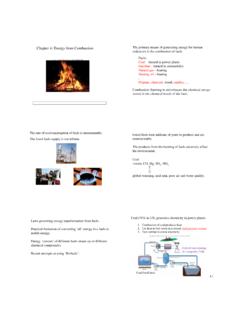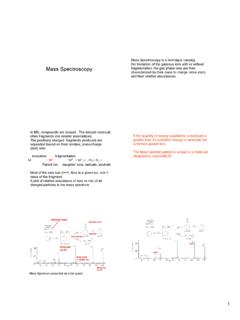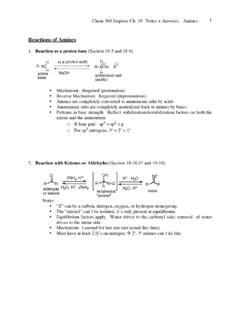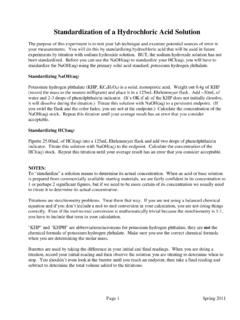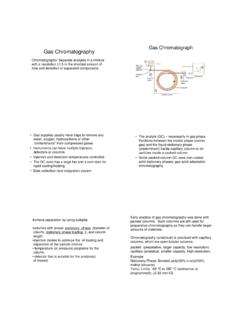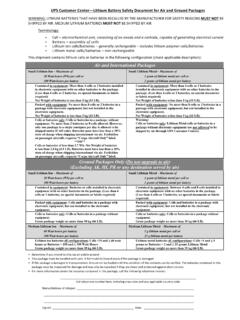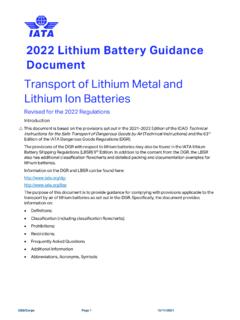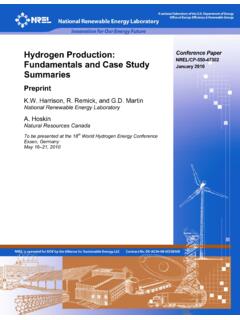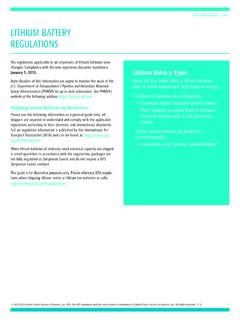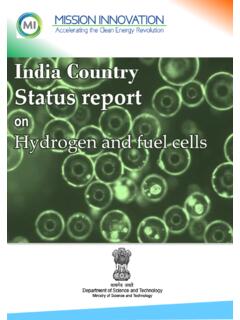Transcription of General Chemistry II Jasperse Electrochemistry. Extra ...
1 1 General Chemistry II Jasperse Electrochemistry. Extra Practice Problems Oxidation Numbers p1 Free Energy and Equilibrium p10 Balancing Redox; Electrons Transferred; Oxidizing Agents; Reducing Agents p2 K Values and Voltage p11 Spontaneous Voltaic electrochemical cells p4 Nonstandard Concentrations and Cell Potential p11 Cell Potentials p5 Electrolysis p12 Predictable Oxidation and Reduction Strength Patterns p8 Ranking Relative Activity, Based on Observed Reactivity or Lack Thereof p9 Answer Key p13 Key Equations Given for Test: E cell=E reduction + E oxidation G = cell ( G in kJ) Ecell = E [ ]log Q log K = nE Mol e = [A time (sec)/96,500] time (sec)= mol e 96,500/current (in A) t = (t1/2 ) ln (Ao/At) ln (Ao/At) = t /t1/2 E = mc2 (m in kg, E in J, c = 3x108 m/s) Oxidation Numbers 1. What is the oxidation number of chromium in the ionic compound ammonium dichromate, (NH4)2Cr2O7?
2 A. +3 d. +6 b. +4 e. +7 c. +5 2. What is the oxidation number of carbon in the ionic compound potassium carbonate, K2CO3? a. +3 d. +6 b. +4 e. +7 c. +5 3. What are the oxidation numbers for nickel, sulfur, and oxygen in Ni2(SO4) 3? a. Ni +3; S +6; O -2 d. Ni +2; S +2; O -2 b. Ni +2; S +4; O -2 e. Ni +2; S +4; O -1 c. Ni +3; S +4; O -2 4. When hydrogen reacts with calcium metal, what are the oxidation numbers of the calcium and hydrogen in the CaH2 product? Ca(s) + H2(g) ! CaH2(s) a. 2 and +1 d. 0 and 0 b. +1 and 2 e. +2 and 2 c. +2 and 1 5. What are the original and final oxidation numbers for iron in the smelting of iron from iron oxide? Fe2O3(s) + 3CO(g) ! 2Fe(s) + 3CO2(g) a. +2 ! 0 d. +6 ! 0 b. +3 ! 0 e. No change c. 0 ! +2 TTT1. Treat Polyatomics as a "package" (helpful shortcut)2. Sum Oxidation Numbers3. Memorize rules/priorities.
3 4. Suggestion: Write "individual" charges above, "sum" below Memorize priority in ox. # rules:elements > simple obvious ions > G1,G2 metal cation charge > H (+1) > O (-2) > halogen (-1) >deduce the rest. Memorize priority in ox. # rules:elements > simple obvious ions > G1,G2 metal cation charge > H (+1) > O (-2) > halogen (-1) >deduce the rest. 2 Balancing Redox; Electrons Transferred; Oxidizing Agents; Reducing Agents 6. Balance the following reaction. How many electrons are transferred? Mg + O2 MgO a. 3 b. 4 c. 6 d. 8 e. 2 7. Methanol fuel cells use the following reaction. How many electrons are transferred in this redox reaction as written? 2CH3OH + 3O2 2CO2 + 3H2O a. 3 d. 12 b. 6 e. 2 c. 8 8. What is the coefficient for hydroxide, and how many electrons are transferred after balancing the reaction?
4 Pb(OH)42- + ClO- PbO2 + Cl- + OH- + H2O a. 2 OH- and 2 electrons d. 2 OH- and 4 electrons b. 3 OH- and 4 electrons e. None of the above c. 1 OH- and 2 electrons 9. Cobalt is one of many metals that can be oxidized by nitric acid. Balance the following the reaction. How many electrons are transferred, and what would be the coefficient for H2O in the balanced reaction? Co + NO3 + H+ NO + H2O + Co2+ a. 3 electrons; 2 H2O d. 6 electrons; 4 H2O b. 6 electrons; 6 H2O e. None of the above c. 4 electrons; 2 H2O 10. What was oxidized and what was reduced in the following reaction? 2Hg2+ + N2H4 2Hg + N2 + 4H+ a. Hg2+ was oxidized; N2H4 was reduced d. Hg2+ was reduced; N2H4 was reduced b. Hg2+ was reduced; N2H4 was oxidized e. None of the above c. Hg2+ was oxidized; N2H4 was oxidized TTT1.
5 Identify Ox #'s for everything2. Identify which change3. For diatomics, initially use a "1" coefficient, and balance atoms 4. How many electrons gained/lost?5. Balance 1. Balance redox atoms first2. Balance charges3. Balance spectator atoms -Between balancing charges and atoms, either can be done firstDetermine all oxidation numbers and see which change!"Oxidized" Ox # increased"Reduced" Ox # reduced 3 11. The following reaction occurs in basic solution. Identify the oxidizing agent. Note the reaction equation is not balanced. H2O(l) + Zn(s) + NO3 (aq) + OH (aq) Zn(OH)42 (aq) + NH3(aq) a. Zn(s) d. H2O(l) (the oxygen) b. NO3 (aq) (the nitrogen) e. NH3(aq) (the nitrogren) c. OH (aq) 12. For the following reaction, which statement, A D, is not correct? If more than one is not correct, respond E. 2Au + 4Cl2 2 AuCl4 2 a.
6 Au is the reducing agent. d. The equation is fully balanced. b. Cl2 is the oxidizing agent e. More than one statement is not correct. c. Au is oxidized. 13. Which substance is the reducing agent in the following reaction? Ca(s) + Zn2+(aq) Ca2+(aq) + Zn(s) a. Ca(s) d. Zn(s) b. Zn2+(aq) e. None of the above c. Ca2+(aq) 14. Which substance is the reducing agent in the following reaction? 4H+(aq) + 2Cl-(aq) + MnO2(s) Cl2(g) + Mn2+(aq) + 2H2O(l) a. H+(aq) d. Cl2(g) b. Cl-(aq) e. Mn2+(aq) c. MnO2(s) 15. Which one of the following items does not characterize an oxidizing agent? a. An oxidizing agent gains electrons. b. An oxidizing agent causes another species to be oxidized. c. The oxidation number of an oxidizing agent decreases. d. A good oxidizing agent is a metal in a high oxidation state, such as Mn7+.
7 E. An example of a good oxidizing agent is an alkali metal, such as Na. 16. Which of the following statements about electrochemical cells is true? a. Reduction occurs at the anode b. An element with a high love for electrons is likely to be easily oxidized c. Oxidation occurs at the anode d. Only oxidation half reactions are useful e. none of the above TTT 4 Spontaneous Voltaic electrochemical cells 17. Which statement about a voltaic cell is not correct? a. Chemical species can have their oxidation number decreased at the cathode. b. Reduction occurs at the cathode. c. Usually the cathode is a metal strip. d. Oxidation occurs at the anode. e. Elemental metal is routinely converted to metal cations at the cathode 18. Which statement regarding voltaic cells is not correct? a. Reduction occurs at the cathode. b. Anions move through the barrier/bridge toward the electrode where oxidation is occurring.
8 C. The electrode where reduction is occurring is represented by a positive sign. d. Electrons flow in the external circuit from the cathode to the anode. e. Electrons flow in the external circuit toward the electrode represented by a positive sign. 19. A voltaic cell is constructed based on the oxidation of zinc metal and the reduction of silver metal. Solutions of silver nitrate and zinc nitrate also were used. Locate the silver and the silver nitrate on the diagram. a) silver = b; silver nitrate = a b) silver = d; silver nitrate = b c) silver = d; silver nitrate = c d) silver = d; silver nitrate = a 20. A voltaic cell is constructed based on the oxidation of zinc metal and the reduction of silver metal. Solutions of silver nitrate and zinc nitrate also were used. Locate the zinc nitrate on the diagram, and identify the anode. a) Zinc nitrate = a; anode = d b) Zinc nitrate = a; anode = Zinc c) Zinc nitrate = c; anode = d d) Zinc nitrate = c; anode = Zinc 21.
9 A voltaic cell is constructed based on the oxidation of zinc metal and the reduction of silver metal. Solutions of silver nitrate and zinc nitrate also were used. Which statement is true regarding the direction of electron flow through the external wire? a) Electrons flow from left to right, from the Zinc b) Electrons flow from right to left, to the Zinc c) The zinc electrode will get larger as more zinc forms. d) Anions will flow through the bridge from the zinc side to the silver side 22. For the cell shown, the standard reduction potentials are + V for Ag+ and V for Zn2+. Based on the reduction potentials, the electrode is where the reduction will occur and it is called the . a. Ag, cathode b. Ag, anode c. Zn, cathode d. Zn, anode e. none of the above ~~~~~~~~~~~~~~voltmetersaltbridgewire+ 1M Ag1M Zn2+AgZn TTT 5 Cell Potentials 23.
10 What is E for the following balanced reaction? Zn(s) + Pb2+(aq) Zn2+(aq) + Pb(s) Half-reaction Standard Reduction Potential Zn2+(aq) + 2e Zn(s) Pb2+(aq) + 2e Pb(s) a. + V d. V b. V e. + V c. + V 24. What is E for the following balanced reaction? Al(s) + Fe3+(aq) Al3+(aq) + Fe(s) Half-reaction Standard Reduction Potential Fe3+(aq) + 2e Fe(s) + Al3+(aq) + 2e Al(s) a.
